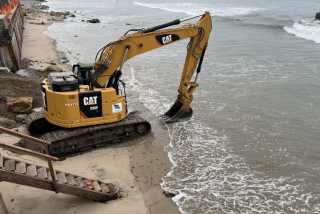U.S. Files Suit to Oust Mob From N.Y. Waterfront
- Share via
NEW YORK — The Justice Department, contending that the mob has dominated the New York and New Jersey waterfront for almost a century, on Wednesday filed a massive civil racketeering lawsuit against top officers of the International Longshoremen’s Assn., several dockworker employers and dozens of reputed Mafia figures.
The civil action seeks to put the entire waterfront under court supervision. The court is being asked to oversee six locals of the 90,000-member longshoremen’s union, to oust corrupt union officers and to hold free elections.
It is only the second time that the government has tried such a tactic with a labor union on such a large scale, and it reflects, in part, the failure of criminal prosecution to break the grip that organized crime figures are said to have on the union.
Although the government has successfully prosecuted mob figures, including many of the ones named in the civil suit Wednesday, “none of those (criminal sanctions) have removed the pervasive influence of organized crime from the waterfront,” U.S. Atty. Gen. Dick Thornburgh said. He vowed to have “the influence of organized crime removed, root and branch, from the waterfront.”
Government investigation has uncovered evidence that the defendants were involved in extortion, embezzlement of union funds, bribery, mail fraud, assault and murder, Thornburgh said.
Mob domination has not only made the world’s second largest port a dangerous place but has imposed a “hidden tax of payments to organized crime” that has cost consumers millions of dollars, the attorney general added.
Jim McNamara, a spokesman for the ILA, said the union had not been informed by the government about a lawsuit, as is customary. The AFL-CIO, of which the longshoremen’s union is a member, refused to comment.
The lawsuit centers on six locals: 1809, 1909 and 824, all on the West Side of Manhattan; 1084-1 in North Bergen, N. J.; 1588, in Bayonne, N. J., and 1814 in Brooklyn. The international union itself was not named in the suit, which was filed in Manhattan federal court and charges violations of the Racketeer Influenced and Corrupt Organizations Act, known as RICO.
Its defendants include 32 present or former union officers, 21 of whom are described as members or associates of organized crime groups. Among them is John Bowers, who is president of the international union and of three of the six named locals. Bowers is alleged to be a member of a Manhattan organized crime group known as the Westies.
Also named were 12 other people. They include John Gotti, the reputed head of the Gambino crime family, who has been tried on a variety of charges and last week won his third acquittal in a row, and Anthony Salerno, the Genovese family chief who is serving a 100-year prison term for racketeering.
Prosecutors said that the Gambino family controlled the New York waterfront and the Genovese family influenced the New Jersey area.
Bruce Cutler, Gotti’s lawyer, said the latest civil suit was part of the government’s “continuing vendetta” against his client. “It’s a continuing saga of throwing Mr. Gotti into a case he doesn’t belong,” Cutler said.
If they are found guilty, those named in the suit would be ordered to give up any connection with the operation of the waterfront. They could also be forced to give up any illegally obtained gains. Justice Department officials did not give an estimate of how large any monetary penalties might be.
By choosing to pursue a civil suit, the government gave up its chance to seek jail terms or other criminal penalties. However, a civil complaint imposes a lower standard of proof and allows the use of previous convictions as evidence.
Corruption in the longshoremen’s union has been the focus of government investigations since the 1950s. In 1986, the President’s Commission on Organized Crime singled out four unions--the ILA, International Brotherhood of Teamsters, the Hotel Employees and Restaurant Employees International and the Laborers International Union of North America--as having ties to the mob. The ILA, the commission wrote, “has been virtually a synonym for organized crime in the labor movement.”
Removing or prosecuting individual union officers has amounted to a “game of musical chairs. We know only too well that out of office is not out of power,” said Leonard Newman, executive director of the Waterfront Commission of New York Harbor.
The President’s commission urged the government to make use of the far-reaching RICO statute in its efforts to break the hold of organized crime on the unions. In 1988, the Justice Department filed a RICO suit seeking to oust the leadership of the 1.6-million-member Teamsters Union, the nation’s largest union, and seize control of the union itself.
More than 250 congressmen and Massachusetts Gov. Michael S. Dukakis, the former Democratic presidential nominee, publicly opposed the use of the RICO statute to take over a union. Amid intense controversy, the Teamster case was settled last year with an agreement that established a three-member independent review board to settle corruption problems in the union.
“The Teamsters are one down. Now you’ve got the ILA. Now we have two more to go (of the four unions named by the presidential commission). Eventually, we’re going to clean these unions up,” said Notre Dame law professor G. Robert Blakey, who as a Senate aide helped draft the RICO statute in 1970. “It’s intolerable in a free society to permit mobsters to exercise this kind of private power.”
The suit against the longshoremen’s union differs from the action against the Teamsters in several respects: It targets only six locals, rather than the entire union, and encompasses the entire operation of the waterfront by targeting employers in industries affecting waterfront commerce.
More to Read
Sign up for Essential California
The most important California stories and recommendations in your inbox every morning.
You may occasionally receive promotional content from the Los Angeles Times.












